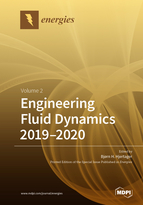Engineering Fluid Dynamics 2019-2020
A special issue of Energies (ISSN 1996-1073). This special issue belongs to the section "I: Energy Fundamentals and Conversion".
Deadline for manuscript submissions: closed (1 August 2020) | Viewed by 111382
Special Issue Editor
Interests: process/chemical engineering; fluid mechanics and transport processes; industrial and environmental flows; multiphase chemical reactors; chemical reactions in turbulent flows; combustion hazards
Special Issues, Collections and Topics in MDPI journals
Special Issue Information
Dear Colleagues,
Over the last few decades, the use of computational fluid dynamics (CFD) and experimental fluid dynamics (EFD) methods have penetrated into all fields of engineering. CFD is now becoming a routine analysis tool for design in some fields (e.g., the aerodynamics of vehicles), and its implementation in other fields (e.g., chemical and marine application) is quickly being adopted. Additionally, in the last decade, open source software has had a tremendous impact on the use of CFD. Laser-based methods have also made significant improvements in the methods used to obtain data for the validation of the CFD codes.
The present Special Issue invites contributions on the topic of engineering fluid dynamics, of both experimental and computational studies. Of special interest are submissions from the fields of mechanical, chemical, marine, safety, and energy engineering. We welcome both original research articles and review articles.
Prof. Dr. Bjørn Hjertager
Guest Editor
Manuscript Submission Information
Manuscripts should be submitted online at www.mdpi.com by registering and logging in to this website. Once you are registered, click here to go to the submission form. Manuscripts can be submitted until the deadline. All submissions that pass pre-check are peer-reviewed. Accepted papers will be published continuously in the journal (as soon as accepted) and will be listed together on the special issue website. Research articles, review articles as well as short communications are invited. For planned papers, a title and short abstract (about 100 words) can be sent to the Editorial Office for announcement on this website.
Submitted manuscripts should not have been published previously, nor be under consideration for publication elsewhere (except conference proceedings papers). All manuscripts are thoroughly refereed through a single-blind peer-review process. A guide for authors and other relevant information for submission of manuscripts is available on the Instructions for Authors page. Energies is an international peer-reviewed open access semimonthly journal published by MDPI.
Please visit the Instructions for Authors page before submitting a manuscript. The Article Processing Charge (APC) for publication in this open access journal is 2600 CHF (Swiss Francs). Submitted papers should be well formatted and use good English. Authors may use MDPI's English editing service prior to publication or during author revisions.
Keywords
- chemical reactors
- fluidized beds
- bioreactors
- combustors
- wind turbines
- offshore structures
- open source CFD software
- explosions
- dispersion
- fires
- multiphase flows
- laser doppler anemometry (LDA)/phase doppler anemometry (PDA)/laser doppler velocimetry (LDV)
- particle image velocimetry (PIV)/planar laser induced fluorescence (PLIF)






